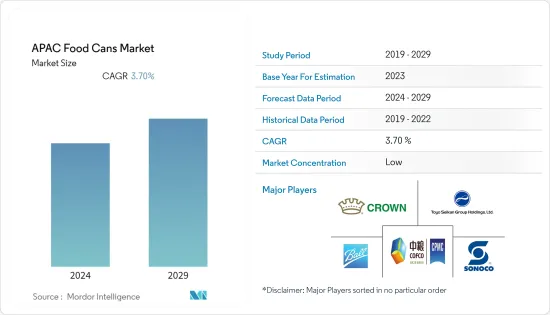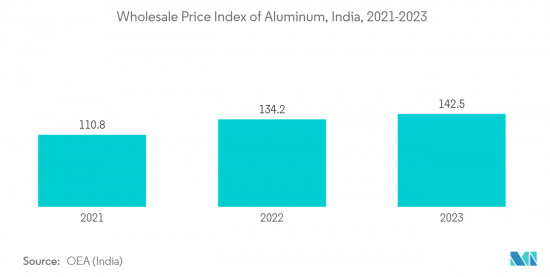PUBLISHER: Mordor Intelligence | PRODUCT CODE: 1408537

PUBLISHER: Mordor Intelligence | PRODUCT CODE: 1408537
APAC Food Cans - Market Share Analysis, Industry Trends & Statistics, Growth Forecasts 2024 - 2029

The Asia-Pacific food cans market was valued at USD 6.39 billion in 2024 and is expected to be valued at USD 7.7 billion by 2029 with a CAGR of 3.7% over the forecast period. Metal cans play a vital role in preserving food without microbiological spoilage. The cans are corrosion-resistant and have the extended shelf life of any package. Its advantages include stiffness, stability, and strong barrier qualities.
Key Highlights
- One of the primary drivers of the market is an upsurge in demographic population, increased consumption of canned food to account for the busy and modern lifestyles, increasing demand for easily accessible and transportable food, the increased necessity to expand the shelf life of food, and an increasing number of pet owners demanding canned pet food.
- According to the International Monetary Fund, solid growth in emerging markets in Asia is anticipated to continue. According to the IMF, annual Gross Domestic Product (GDP) growth of 4.6% for emerging and developing Asia in 2022 will be increasing to 5% in 2023. By investing in research and development, boosting entrepreneurship, and strengthening digitalization, Asian countries can foster sustainable, long-term growth. Such growth in the economies would further leverage the canned food market as more individuals will be working and prefer ready meals.
- Consumer trends, such as a choice for small-size and multi-pack packaging formats, support the volume growth of aluminum cans, especially for the ready-to-eat food segment. Hence, most of the companies across the emerging regions offer mini-cans, which usually contain smaller volumes of products at less cost than traditional canned products. For instance, food innovations in canned seafood in Southeast Asia are witnessing growth. As a seafood provider, Thai Union announced it would launch a plant-based canned tuna per the rising consumer demand.
- The presence of alternatives like plastic packaged food, which is cost-effective but has a lesser shelf life, restricts the market's growth. Despite not being durable, plastics are still gaining demand over glass and metals in terms of energy consumption, reliability, and sustainability. Also, the material is flexible and can be molded into any shape as required.
- The food industry, with a significant share in the can packaging market, has witnessed massive demand during the COVID-19 pandemic, as the initiative falls under the essential commodity. The lockdown enforced across the region due to the COVID-19 pandemic has significantly changed consumption habits. There has been an increased demand for packaged food products, meat, vegetables, and fruits. Packaging designs and materials that address hygiene and consumer safety concerns minimize the possibility of the survival of the virus on the packaging material, which is expected to be a mandatory factor when deciding on the packaging material. Hence, the adoption of metal packaging is anticipated to rise owing to its chemical properties.
APAC Food Cans Market Trends
Aluminum Cans to Witness Growth in the Market
- Aluminum is the primarily used material for manufacturing cans as it is infinitely recyclable. It provides a superior metal canvas for 360-degree labeling and helps to protect the flavor and freshness of food packed inside, which manufacturers mostly prefer.
- The demand for aluminum cans is increasingly driven by manufacturers of ready-to-eat food for storage as they help improve packing efficiency in terms of lower transportation costs and significant brand engagement benefits. Aluminum can sales are increasing due to consumer trends such as a preference for smaller, multi-pack packaging formats, particularly in the ready-to-eat food segment. As a result, many companies offer mini cans with smaller amounts of products that are typically less expensive than traditional cans.
- Recently, Ayam Sarl, a plant-based food company, has designed delicious products formulated by Asians for Asians in formats that its customer base could use day-to-day in their preferred traditional dishes without compromising taste or convenience. Hence, the company launched Yumeat. While many plant-based meat and seafood products occupy supermarkets' chilled and frozen sections, the company went a different way for its yumeat products. It launched shelf-stable cans that do not require refrigeration. This meant the company could outperform its competitors in two key areas: convenience and affordability. Such innovations in the region would leverage the market for food cans.
- Moreover, the wholesale price index of aluminum across India in 2023 is 142.5, according to OEA India, and it was 134.2 in 2022. Also, from being primarily a consuming country, Indonesia is now spreading its wings as a key exporter of cans in the Asian market. Indonesia exports aluminum cans to several countries, including Brunei Darussalam, France, Malaysia, Nigeria, Oman, Papua New Guinea, the Philippines, etc.

India to Gain Highest Growth
- The demand for canned food packaging in India has extended drastically, spurred by the fast growth in consumer markets, particularly in processed food. The packaging industry is driven by a rising population, increasing income levels, and changing lifestyles, which are anticipated to drive consumption across various sectors, leading to higher demand for packaging solutions. Moreover, demand from the rural sector for packaged products is fueled by the growing media penetration through the Internet and television.
- According to the Indian Institute of Packaging (IIP), packaging consumption in India has increased by nearly 200% in the last decade. Further, India is emerging as an organized retail destination in the world. The presence of e-commerce is expanding and is bringing about a revolution in the retail sector, driving the need for packaging. Therefore, organized retail services and the boom in e-commerce offer enormous potential for the future growth of retailing in India, which in turn is promoting the growth of the packaging sector. Such factors drive the food cans market in the country.
- According to the Ministry of Environment, Forest and Climate Change in December 2022, the Plastic Waste Management Rules, 2016, provide the statutory framework and the authorities for enforcement of the rules, including a ban on identified single-use plastic items. As sustainability has become a key concern, packaging industry end-users, including online marketplaces, have switched to sustainable solutions. Such a ban on single-use plastics would leverage the country's metal cans market.
- The Ministry of Food Processing Industries (MoFPI) is taking all measures to boost investments across the value chain. The food processing industry has a share of 12.38% in the employment generated in all Registered Factory sectors, engaging approximately 1.93 million people. Major sectors constituting the food processing industry in India are grains, sugar, edible oils, beverages, and dairy products.
- The food processing sector is driven by changing demographics and lifestyles, the availability of raw materials, and more. According to the USDA Foreign Agricultural Service, the sales value of processed fruits and vegetables in India was USD 300 million in 2022. The country's processed food sector is booming with opportunities, and the government is also focused on sustainable packaging solutions, driving the market growth over the forecast period in the country.
APAC Food Cans Industry Overview
The competitive rivalry in the Asia-Pacific food cans market is high owing to many key players continually trying to gain maximum market share through collaborations, investments, and more. Some of the major players are Crown Holdings, Inc., Ball Corporation, Visy Industries, Toyo Seikan Group Holdings, Ltd., and more.
In February 2023, Toyo Seikan Group Holdings, Ltd. and UACJ Corporation agreed to jointly study ways to promote the horizontal recycling of aluminum cans further. This business partnership aims to develop and commercialize aluminum cans with added environmental value by leveraging the technologies and know-how of both companies.
Additional Benefits:
- The market estimate (ME) sheet in Excel format
- 3 months of analyst support
TABLE OF CONTENTS
1 INTRODUCTION
- 1.1 Study Assumptions and Market Definition
- 1.2 Scope of the Study
2 RESEARCH METHODOLOGY
3 EXECUTIVE SUMMARY
4 MARKET INSIGHTS
- 4.1 Market Overview
- 4.2 Industry Value Chain Analysis
- 4.3 Industry Attractiveness - Porter's Five Forces Analysis
- 4.3.1 Bargaining Power of Suppliers
- 4.3.2 Bargaining Power of Buyers
- 4.3.3 Threat of New Entrants
- 4.3.4 Threat of Substitute Products
- 4.3.5 Intensity of Competitive Rivalry
- 4.4 Impact of Ukraine-Russia Standoff on the Market
5 MARKET DYNAMICS
- 5.1 Market Drivers
- 5.1.1 New Packaging Styles and High Potential in Emerging Economies
- 5.1.2 Increased Demand for Ready-to-Eat Foods
- 5.2 Market Restraints
- 5.2.1 High Use of Plastic Material Due to Lower Costs
6 MARKET SEGMENTATION
- 6.1 By Material Type
- 6.1.1 Aluminium Cans
- 6.1.2 Steel Cans
- 6.2 By Application
- 6.2.1 Ready Meals
- 6.2.2 Powder Products
- 6.2.3 Fish and Seafood
- 6.2.4 Fruits and Vegetables
- 6.2.5 Processed Food
- 6.2.6 Pet Food
- 6.2.7 Other Applications
- 6.3 By Country
- 6.3.1 China
- 6.3.2 India
- 6.3.3 Japan
- 6.3.4 South Korea
- 6.3.5 Rest of Asia-Pacific
7 COMPETITIVE LANDSCAPE
- 7.1 Company Profiles
- 7.1.1 Crown Holdings, Inc.
- 7.1.2 Trivium Packaging
- 7.1.3 CPMC Holdings Limited
- 7.1.4 Visy Industries
- 7.1.5 TOYO SEIKAN GROUP HOLDINGS, LTD.
- 7.1.6 KIAN JOO GROUP
- 7.1.7 Ball Corporation
- 7.1.8 Sonoco Products Company
- 7.1.9 Mauser Packaging Solutions
8 INVESTMENT ANALYSIS
9 FUTURE OF THE MARKET




